Telescope Reviews
Page 8
By Ed Ting
Updated 7/15/00
Click on a scope below:
Meade 152ED APO Refractor
Orion Premium Deep Space Explorer 12.5" Dobsonian
Nikon 10 cm (4 inch) f/12 ED Apochromat
Celestron 8" Starhopper Dobsonian
Astro-Physics AP90 Stowaway APO refractor
1) Meade 152 ED APO Refractor (4/27/99)
(6" doublet ED apochromatic refractor, mount, drives, 2" diagonal,
8X50 finder, $4995, $5790 as tested)
(Note: see also reviews of the 4" 102ED and the 7" 178ED models in this series)
We tested this telescope alongside its big brother, the 7" 178ED. The
neighbors must have wondered what was happening, as there were now
two huge cannons in the yard pointing into the sky.
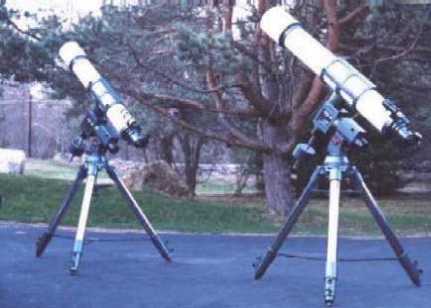 Meade's Big Guns -- the 152 ED (left) and the 178ED (right)
This is the third of Meade's ED refractor series that I've evaluated so
far, and I'm pleased to report that this 6" unit had none of the mech-
anical or optical problems found in previous samples of the 4" and 7"
scopes.
The 6" Meade APO showed some very minor undercorrection (about 1/4
wave or so) and exhibited almost no false color. The optics were sharp
and the views were impressively constrasty. Along with the 178ED, we
also had a Celestron 102ED and my FS102 nearby. In this august company,
the 6" Meade kept up very nicely, and some thought that it was even a
little sharper than the 178ED.
We picked out some detail in the Alpine Valley near Plato and split several
close doubles in the area, including the 1.3 arc-second Xi Ursa Major (the
atmosphere wouldn't support anything much closer.) Mars was at opposition,
although the red planet wasn't showing many features this evening.
If Meade could build all of their ED refractors this well (and consistently)
they should be considered major bargains in the premium-refractor world.
For those looking to make a "statement" in a refractor, the 152ED is a
good alternative to the 178ED -- it gathers almost as much light, but it's
easier to haul around. Also, the slightly smaller lenses should be easier
to manufacture to precise tolerances. Finally, the smaller tube is a lighter
load for the LXD750 mount.
Meade's Big Guns -- the 152 ED (left) and the 178ED (right)
This is the third of Meade's ED refractor series that I've evaluated so
far, and I'm pleased to report that this 6" unit had none of the mech-
anical or optical problems found in previous samples of the 4" and 7"
scopes.
The 6" Meade APO showed some very minor undercorrection (about 1/4
wave or so) and exhibited almost no false color. The optics were sharp
and the views were impressively constrasty. Along with the 178ED, we
also had a Celestron 102ED and my FS102 nearby. In this august company,
the 6" Meade kept up very nicely, and some thought that it was even a
little sharper than the 178ED.
We picked out some detail in the Alpine Valley near Plato and split several
close doubles in the area, including the 1.3 arc-second Xi Ursa Major (the
atmosphere wouldn't support anything much closer.) Mars was at opposition,
although the red planet wasn't showing many features this evening.
If Meade could build all of their ED refractors this well (and consistently)
they should be considered major bargains in the premium-refractor world.
For those looking to make a "statement" in a refractor, the 152ED is a
good alternative to the 178ED -- it gathers almost as much light, but it's
easier to haul around. Also, the slightly smaller lenses should be easier
to manufacture to precise tolerances. Finally, the smaller tube is a lighter
load for the LXD750 mount.
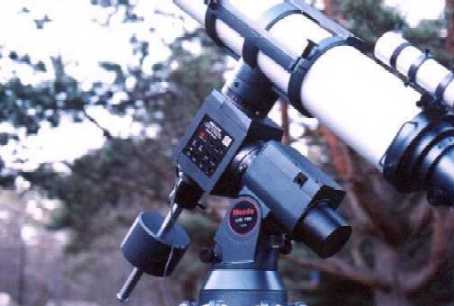 The LXD750 Mount
At $5000+, the scope isn't exactly cheap, but consider that the AP155
sells for $4995 for the OTA alone. The Takahashi FS152 lists for $10,895!
In this context, it's understandable that some might be tempted to give up
that last bit of performance to get a fully-equipped, mounted, and computer-
ized scope like this 152ED, and spend less money in the process.
As with any product this sophisticated, and given our previous experiences
with these Meade APOs, be sure and work with a reputable dealer should
something go wrong or not be to your liking.
A very nice telescope.
Update, 7/00: I've now seen another one of these 152EDs, and the news
on the second sample is generally good as well. The optics are sharp, with
only a trace of false color.
2) Orion Premium Deep Space Explorer 12.5" (5/20/99)
(12.5" f/4.8 Dob, 26 mm Plossl, $899-$1069 depending on vintage and
options)
The Orion DSE Premium scopes look like the conventional cheap Sonotube
Dobs from Meade, Celestron, and Orion's own (black-tubed) DSE scopes,
but a closer look reveals that they're a cut above their less expensive
brothers. Indeed, they are almost in a class by themselves as "Semi-
Premium" Dobsonians.
The LXD750 Mount
At $5000+, the scope isn't exactly cheap, but consider that the AP155
sells for $4995 for the OTA alone. The Takahashi FS152 lists for $10,895!
In this context, it's understandable that some might be tempted to give up
that last bit of performance to get a fully-equipped, mounted, and computer-
ized scope like this 152ED, and spend less money in the process.
As with any product this sophisticated, and given our previous experiences
with these Meade APOs, be sure and work with a reputable dealer should
something go wrong or not be to your liking.
A very nice telescope.
Update, 7/00: I've now seen another one of these 152EDs, and the news
on the second sample is generally good as well. The optics are sharp, with
only a trace of false color.
2) Orion Premium Deep Space Explorer 12.5" (5/20/99)
(12.5" f/4.8 Dob, 26 mm Plossl, $899-$1069 depending on vintage and
options)
The Orion DSE Premium scopes look like the conventional cheap Sonotube
Dobs from Meade, Celestron, and Orion's own (black-tubed) DSE scopes,
but a closer look reveals that they're a cut above their less expensive
brothers. Indeed, they are almost in a class by themselves as "Semi-
Premium" Dobsonians.
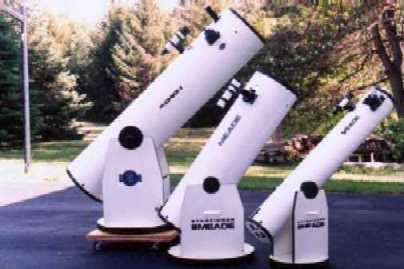 Eeeny, Meeny, Miney, Dob...
The Orion 12.5" DSE, with the 10" and 6" Starfinders
For instance, the DSE Premium scopes have real Ebony Star Formica
on teflon for the azimuth bearings. Also, the primary is made of pyrex
and has enhanced (94%) coatings. There are convenient handles for
transporting the tube (these will, however, impale you in the leg during
your first few observing sessions, until you become more aware of them.)
Finally, the feet are longer than usual, making the scope less sensitive
to uneven terrain.
You would think that a 12.5" f/4.8 Dob wouldn't be that much larger than
a 10" f/4.5 Starfinder, but that isn't the case. While the Meade is still
portable, the Orion is a Really Big Telescope (see photo.)
The scope has nearly perfect spherical correction, and gives fine images.
What's more, the smooth bearings and fine optics allow easy tracking at
powers well over 200X, rare for a Sonotube Dob. M82 takes on a wispy
cruller-like appearance, and I can start to see some real detail in gal-
axies that were mere smudges in all of my other scopes. All four members
of the NGC3190 group are visible, and the Siamese Twins are easily split.
I'm impressed.
Drawbacks? I don't like the helical focuser, well-made as it is. No finder
is included in the price. Also, the three collimation screws stick out of
the back of the tube, preventing you from setting the huge 61 lb tube on
its back while you move the rocker box. And the 37 lb rocker box itself
doesn't have any handles. It's almost as if Orion doesn't want you moving
this telescope. Finally, you'll have to wait for one. Delivery runs several
months for these scopes.
There seem to be older and newer "versions" of this scope. They are all
the same, however, except for updated graphics and logos. Logo changes
appear to correlate with price increases from Orion.
The last thing I needed was another telescope, but after seeing the fine
mechanical and optical performance of this unit, and discovering that it
was for sale, I couldn't help myself. It's now sitting in my garage.
3) Nikon 10 cm (4 inch) f/12 ED Apochromat (5/26/99)
(100 mm f/12 ED doublet APO refractor, 7X50 illuminated finder,
many accessories, case, "about $4100" NLA)
Apochromatic refractors from Pentax and Nikon are available in many
parts of the world, but not, apparently, in the US. Thus, there has
been a great deal of hearsay and speculation here about these instruments.
According to the (Japanese-only) brochure, Nikon made a 65 mm APO
and a 65 mm Achromat in this same series, as well as a sharp-looking
equatorial mount and more accessories than I could care to count.
There is even a line of Nikon eyepieces. As is the custom in Japan,
.965" barrels are standard. These scopes were discontinued by Nikon
around 1991; as of now, the only Nikon astronomical products available
are the eyepieces, some accessories, and 6", 8", and 10" refractors
for professional use.
Eeeny, Meeny, Miney, Dob...
The Orion 12.5" DSE, with the 10" and 6" Starfinders
For instance, the DSE Premium scopes have real Ebony Star Formica
on teflon for the azimuth bearings. Also, the primary is made of pyrex
and has enhanced (94%) coatings. There are convenient handles for
transporting the tube (these will, however, impale you in the leg during
your first few observing sessions, until you become more aware of them.)
Finally, the feet are longer than usual, making the scope less sensitive
to uneven terrain.
You would think that a 12.5" f/4.8 Dob wouldn't be that much larger than
a 10" f/4.5 Starfinder, but that isn't the case. While the Meade is still
portable, the Orion is a Really Big Telescope (see photo.)
The scope has nearly perfect spherical correction, and gives fine images.
What's more, the smooth bearings and fine optics allow easy tracking at
powers well over 200X, rare for a Sonotube Dob. M82 takes on a wispy
cruller-like appearance, and I can start to see some real detail in gal-
axies that were mere smudges in all of my other scopes. All four members
of the NGC3190 group are visible, and the Siamese Twins are easily split.
I'm impressed.
Drawbacks? I don't like the helical focuser, well-made as it is. No finder
is included in the price. Also, the three collimation screws stick out of
the back of the tube, preventing you from setting the huge 61 lb tube on
its back while you move the rocker box. And the 37 lb rocker box itself
doesn't have any handles. It's almost as if Orion doesn't want you moving
this telescope. Finally, you'll have to wait for one. Delivery runs several
months for these scopes.
There seem to be older and newer "versions" of this scope. They are all
the same, however, except for updated graphics and logos. Logo changes
appear to correlate with price increases from Orion.
The last thing I needed was another telescope, but after seeing the fine
mechanical and optical performance of this unit, and discovering that it
was for sale, I couldn't help myself. It's now sitting in my garage.
3) Nikon 10 cm (4 inch) f/12 ED Apochromat (5/26/99)
(100 mm f/12 ED doublet APO refractor, 7X50 illuminated finder,
many accessories, case, "about $4100" NLA)
Apochromatic refractors from Pentax and Nikon are available in many
parts of the world, but not, apparently, in the US. Thus, there has
been a great deal of hearsay and speculation here about these instruments.
According to the (Japanese-only) brochure, Nikon made a 65 mm APO
and a 65 mm Achromat in this same series, as well as a sharp-looking
equatorial mount and more accessories than I could care to count.
There is even a line of Nikon eyepieces. As is the custom in Japan,
.965" barrels are standard. These scopes were discontinued by Nikon
around 1991; as of now, the only Nikon astronomical products available
are the eyepieces, some accessories, and 6", 8", and 10" refractors
for professional use.
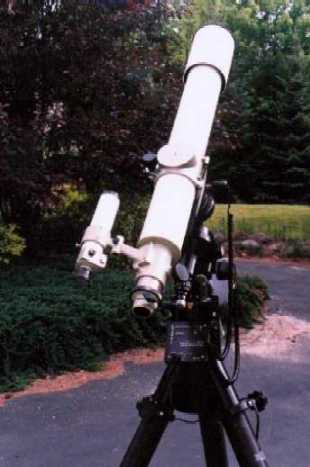 The Nikon APO aboard a G11
This scope was sent to me by Dan Folz, a kind reader from Illinois, as
a review sample. It arrived in a huge, heavy wooden case, a la Unitron.
The scope arrived with an impressive array of extras, including .965",
1.25" and 2" visual backs, a Herschel Wedge, and a huge assortment
of items which attach to the visual back that I did not bother to try
out.
The scope is beefy, heavy, and well-made. It has an impressively solid
tube ring and finder bracket, and the focus knobs are huge and smooth.
However, it does fall cosmetically short of the Takahashi and Astro-
Physics products, both of which are practically works of art. The Nikon,
in contrast, has a more workmanlike appearance.
The finder is a conversation piece in itself. Excellent optics are only
the beginning. The adjustable-brightness crosshairs are lighted in a
pleasing, dim green, and don't extend all the way out to the field stop,
for a nice change. The finder bracket attaches to the scope via four
(count 'em, four!) bolts. You're not going to bump this finder out of
alignment any time soon.
The Nikon APO aboard a G11
This scope was sent to me by Dan Folz, a kind reader from Illinois, as
a review sample. It arrived in a huge, heavy wooden case, a la Unitron.
The scope arrived with an impressive array of extras, including .965",
1.25" and 2" visual backs, a Herschel Wedge, and a huge assortment
of items which attach to the visual back that I did not bother to try
out.
The scope is beefy, heavy, and well-made. It has an impressively solid
tube ring and finder bracket, and the focus knobs are huge and smooth.
However, it does fall cosmetically short of the Takahashi and Astro-
Physics products, both of which are practically works of art. The Nikon,
in contrast, has a more workmanlike appearance.
The finder is a conversation piece in itself. Excellent optics are only
the beginning. The adjustable-brightness crosshairs are lighted in a
pleasing, dim green, and don't extend all the way out to the field stop,
for a nice change. The finder bracket attaches to the scope via four
(count 'em, four!) bolts. You're not going to bump this finder out of
alignment any time soon.
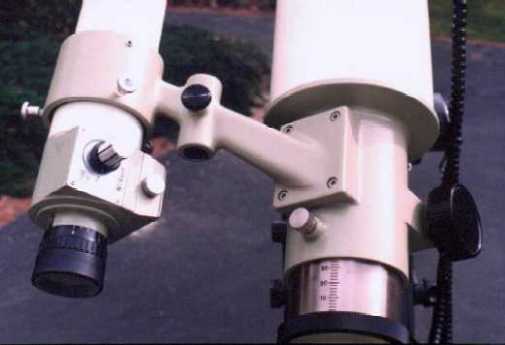 Nikon's attention to detail is apparent. Note the
controls on the finder and the graduated drawtube.
The tube ring arrived attached to a G11 plate, so we supplied our own
G11. After hoisting the large scope on the mount (this may be the only
4" refractor I've ever seen that will overpower a GM8) we waited a while
for the scope to cool down.
Some telescopes flirt with your sensibilities, preventing you from
reaching a concrete conclusion about them right away. The Nikon
isn't one of them. Within a few seconds of looking at the moon, I
knew I was in the presence of something special. The views, at
almost any magnification, were stunning in their contrast and
sharpness.
On the limb of the moon, for example (an acid test for any refractor)
the view snapped from solid, blinding white to pitch-pitch black, with
nothing in between. Even my FS102 will show a tiny trace of light
scatter off the limb at certain magnifications. In addition, there
was no false color to be seen. "I've had reflectors with more color
than this," joked one observer. The star test showed very little
spherical aberration, perhaps 1/8 wave or so in undercorrection.
Vega showed no false color at 300X.
One hallmark of a good telescope is how quickly it takes me out of
"reviewer mode." The Nikon surely qualifies, as I was anxious to
get the testing over with, so I could start using the scope.
Three craterlets were visible on the floor of Plato. I subjected the
scope to a series of double stars, each closer than the next.
Mizar and Epsilon Lyra were split wide open, of course. Izar (Ep-
silon Bootes) easily showed black space between its components at
171X. 1.3 arc second Xi Ursa Major presented no difficulties, and
Porrima, the "Shrinking Double" in Virgo, presented no challenge.
What was most interesting, however, was looking at Zeta Bootes,
which, at around .8 arc seconds, is way below Dawes Limit for a 4"
telescope. At 250X-300X, I saw consistent elongation of the star
in times of steady seeing (this was confirmed by another observer.)
Very impressive.
This telescope sparked a small debate amongst our group. How
much of the telescope's performance is due to the quality of its
optics, and how much is due to the f/12 focal ratio, unusually long
for an APO? The answer, I suspect, is somewhere in between. The
objective has a superb figure on its own, but the long f/ ratio doesn't
hurt. This leads me to wonder how good the Traveler and the FS102
would be if their lenses were refigured to operate at f/12.
Over the past few years, I've had the pleasure of using many refractors,
including the Traveler, FS102, AP130 and AP155, the TeleVue 101, and
the Vixen fluorites, whose performance can be rightly categorized as
"world-class." Add this Nikon to the list.
Update, 8/02: Mike Palermiti measured this sample recently, and reports
that its wavefront correction is even better than I estimated - somewhere
around 1/12 wave. Furthermore, he states that he has measured about five
of these Nikon tubes and they are all within the 1/10-1/12 wave range.
Impressive.
4) Celestron 8" Starhopper Dobsonian (6/27/99)
(8" f/6 reflector, 25 mm SMA, collimating eyepiece, about $500 street)
I've looked through a number of these through the years, and believe
that they represent sound value both for the beginning astronomer and
the more advanced observer looking for a second knock-around scope.
Nikon's attention to detail is apparent. Note the
controls on the finder and the graduated drawtube.
The tube ring arrived attached to a G11 plate, so we supplied our own
G11. After hoisting the large scope on the mount (this may be the only
4" refractor I've ever seen that will overpower a GM8) we waited a while
for the scope to cool down.
Some telescopes flirt with your sensibilities, preventing you from
reaching a concrete conclusion about them right away. The Nikon
isn't one of them. Within a few seconds of looking at the moon, I
knew I was in the presence of something special. The views, at
almost any magnification, were stunning in their contrast and
sharpness.
On the limb of the moon, for example (an acid test for any refractor)
the view snapped from solid, blinding white to pitch-pitch black, with
nothing in between. Even my FS102 will show a tiny trace of light
scatter off the limb at certain magnifications. In addition, there
was no false color to be seen. "I've had reflectors with more color
than this," joked one observer. The star test showed very little
spherical aberration, perhaps 1/8 wave or so in undercorrection.
Vega showed no false color at 300X.
One hallmark of a good telescope is how quickly it takes me out of
"reviewer mode." The Nikon surely qualifies, as I was anxious to
get the testing over with, so I could start using the scope.
Three craterlets were visible on the floor of Plato. I subjected the
scope to a series of double stars, each closer than the next.
Mizar and Epsilon Lyra were split wide open, of course. Izar (Ep-
silon Bootes) easily showed black space between its components at
171X. 1.3 arc second Xi Ursa Major presented no difficulties, and
Porrima, the "Shrinking Double" in Virgo, presented no challenge.
What was most interesting, however, was looking at Zeta Bootes,
which, at around .8 arc seconds, is way below Dawes Limit for a 4"
telescope. At 250X-300X, I saw consistent elongation of the star
in times of steady seeing (this was confirmed by another observer.)
Very impressive.
This telescope sparked a small debate amongst our group. How
much of the telescope's performance is due to the quality of its
optics, and how much is due to the f/12 focal ratio, unusually long
for an APO? The answer, I suspect, is somewhere in between. The
objective has a superb figure on its own, but the long f/ ratio doesn't
hurt. This leads me to wonder how good the Traveler and the FS102
would be if their lenses were refigured to operate at f/12.
Over the past few years, I've had the pleasure of using many refractors,
including the Traveler, FS102, AP130 and AP155, the TeleVue 101, and
the Vixen fluorites, whose performance can be rightly categorized as
"world-class." Add this Nikon to the list.
Update, 8/02: Mike Palermiti measured this sample recently, and reports
that its wavefront correction is even better than I estimated - somewhere
around 1/12 wave. Furthermore, he states that he has measured about five
of these Nikon tubes and they are all within the 1/10-1/12 wave range.
Impressive.
4) Celestron 8" Starhopper Dobsonian (6/27/99)
(8" f/6 reflector, 25 mm SMA, collimating eyepiece, about $500 street)
I've looked through a number of these through the years, and believe
that they represent sound value both for the beginning astronomer and
the more advanced observer looking for a second knock-around scope.
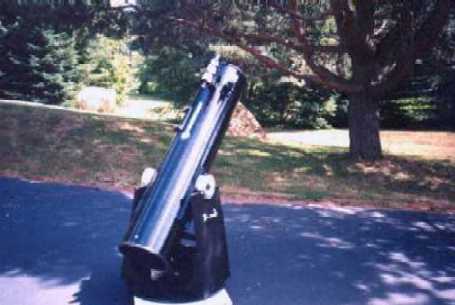 Mine is the older version, with the single-stalk secondary and the
larger, black rocker box. Newer (white rocker box) versions are
more desirable since they tend to hold their altitude position a
little better. Those artfully-angled pieces on my rocker box may
look cool, but they don't hold the aluminum side bearings as snugly
as they could. I had problems getting the scope to hold still until
I replaced the cheesy friction pads with plastic furniture glides.
These Starhoppers come with an innovative weight transfer system.
You slide the tube forward and backward on dovetails cut into the
altitude bearings. Even with an 8X50 Orion finder aboard, there's
still room left to move the scope forward. This is the first Dob
I've owned in which I did not have to rig up a complicated counter-
weight system.
The scope's optics are very good. I've spent many enjoyable nights
looking at the summer Messier objects. Going through areas like the
Virgo Cluster is much easier with an 8" telescope as opposed to a 6".
On the used market, look for white rocker box versions. The silly
paper decals on the side panels peel off almost immediately in damp
weather, so don't worry if they're missing. Also, the availability of
these Starhoppers, and their kissing-cousins, the Orion DSE units,
is in question right now, as Discovery Telescope ventures out on
their own. Discovery made/makes both the Orion and Celestron
Dobs. So as of this writing (June 1999) there is a big mess to sort
out as to what's available and what isn't. Check before ordering.
Recommended.
Sidebar: Should you buy a Meade or Celestron Dob? I am often
asked this question by readers looking for Dobs in the 6"-8" range.
In short, both offer excellent value and have very good optics, but
there are a few differences.
The Meades come with better eyepieces (the 26 mm Series 4000
Plossl) are lighter and more compact, and look better, at least to
my eyes. They also cost less. On the downside, the Meade units have
cheap particle board mirror cells, and come with questionable focusers
like the cheap all-plastic 2" #77 unit.
In contrast to the Meade Dob, which is a compact, svelte little damsel,
the Celestrons take the opposite approach. This is a big girl. The
azimuth ground board is huge -- 21" in diameter, the same size as the
one on my 12.5" Orion DSE. Subjectively, the 8" Starhopper has almost
the same apparent bulk as my (recently departed) Meade 10" f/4.5
Starfinder Dob.
However, the increased size and weight translate into better stability.
Celestron's focuser is plastic, like Meade's, but seems to be a lot
sturdier. And the sliding dovetail assembly is a neat feature. Also,
the open metal mirror cell is far superior to the particle-board unit
on the Meades (the Celestron mirror itself is thinner at the edges than
in the center, giving it a "petri dish" look.) If these things matter to
you, consider spending the extra money to get the Starhopper. If
they don't, and you want maximum portability, get the Meade.
5) Astro-Physics AP90 Stowaway (7/9/99)
(92.5 mm f/5 oil-spaced triplet apochromat, OTA only, case, sliding bar,
$2400)
These limited-production scopes were sold by invitation-only in June and
July of 1999. As with any Astro-Physics product, details about its avail-
ability are sketchy at best. Estimates of the total number of these units
range from 40 to "just under one hundred." If there are only 40 of these
out there, they are truly collector's items!
Mine is the older version, with the single-stalk secondary and the
larger, black rocker box. Newer (white rocker box) versions are
more desirable since they tend to hold their altitude position a
little better. Those artfully-angled pieces on my rocker box may
look cool, but they don't hold the aluminum side bearings as snugly
as they could. I had problems getting the scope to hold still until
I replaced the cheesy friction pads with plastic furniture glides.
These Starhoppers come with an innovative weight transfer system.
You slide the tube forward and backward on dovetails cut into the
altitude bearings. Even with an 8X50 Orion finder aboard, there's
still room left to move the scope forward. This is the first Dob
I've owned in which I did not have to rig up a complicated counter-
weight system.
The scope's optics are very good. I've spent many enjoyable nights
looking at the summer Messier objects. Going through areas like the
Virgo Cluster is much easier with an 8" telescope as opposed to a 6".
On the used market, look for white rocker box versions. The silly
paper decals on the side panels peel off almost immediately in damp
weather, so don't worry if they're missing. Also, the availability of
these Starhoppers, and their kissing-cousins, the Orion DSE units,
is in question right now, as Discovery Telescope ventures out on
their own. Discovery made/makes both the Orion and Celestron
Dobs. So as of this writing (June 1999) there is a big mess to sort
out as to what's available and what isn't. Check before ordering.
Recommended.
Sidebar: Should you buy a Meade or Celestron Dob? I am often
asked this question by readers looking for Dobs in the 6"-8" range.
In short, both offer excellent value and have very good optics, but
there are a few differences.
The Meades come with better eyepieces (the 26 mm Series 4000
Plossl) are lighter and more compact, and look better, at least to
my eyes. They also cost less. On the downside, the Meade units have
cheap particle board mirror cells, and come with questionable focusers
like the cheap all-plastic 2" #77 unit.
In contrast to the Meade Dob, which is a compact, svelte little damsel,
the Celestrons take the opposite approach. This is a big girl. The
azimuth ground board is huge -- 21" in diameter, the same size as the
one on my 12.5" Orion DSE. Subjectively, the 8" Starhopper has almost
the same apparent bulk as my (recently departed) Meade 10" f/4.5
Starfinder Dob.
However, the increased size and weight translate into better stability.
Celestron's focuser is plastic, like Meade's, but seems to be a lot
sturdier. And the sliding dovetail assembly is a neat feature. Also,
the open metal mirror cell is far superior to the particle-board unit
on the Meades (the Celestron mirror itself is thinner at the edges than
in the center, giving it a "petri dish" look.) If these things matter to
you, consider spending the extra money to get the Starhopper. If
they don't, and you want maximum portability, get the Meade.
5) Astro-Physics AP90 Stowaway (7/9/99)
(92.5 mm f/5 oil-spaced triplet apochromat, OTA only, case, sliding bar,
$2400)
These limited-production scopes were sold by invitation-only in June and
July of 1999. As with any Astro-Physics product, details about its avail-
ability are sketchy at best. Estimates of the total number of these units
range from 40 to "just under one hundred." If there are only 40 of these
out there, they are truly collector's items!
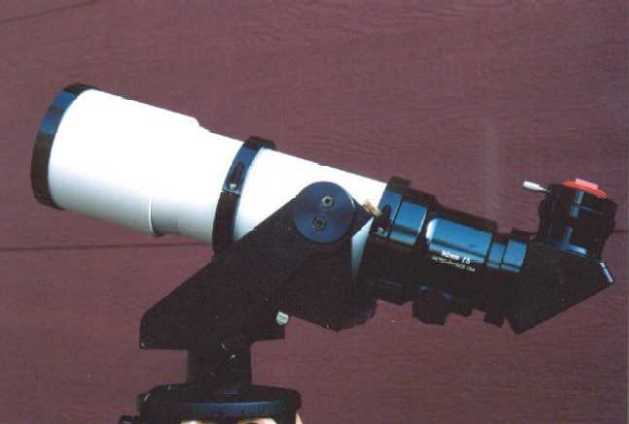 Revenge of the Cute-Scope! The Stowaway
The Stowaway has a short-short 450 mm focal length, and uses a brand
new 2" focuser with fine and coarse adjustment knobs. The "fine" knob
sits concentrically inside the right-hand focusing knob and is geared
down 10:1. I found this very handy, and wish more scope manufacturers
would copy it. The drawtube has a very generous amount of in travel
in order to accomodate a Zeiss binoviewer without a barlow. Indeed,
the scope is so short to begin with that the focuser and visual back
take up more than half the length of the entire scope!
It's hard to put into words how small this telescope is. It is literally
the size of a fat Pronto, and even has a similar textured pebble finish
like the TeleVue scopes. The Traveler (already a very small telescope)
dwarfs the Stowaway. If the Traveler is cute, the Stowaway is downright
adorable. If I were its grandmother, I'd want to pinch its cheek.
Revenge of the Cute-Scope! The Stowaway
The Stowaway has a short-short 450 mm focal length, and uses a brand
new 2" focuser with fine and coarse adjustment knobs. The "fine" knob
sits concentrically inside the right-hand focusing knob and is geared
down 10:1. I found this very handy, and wish more scope manufacturers
would copy it. The drawtube has a very generous amount of in travel
in order to accomodate a Zeiss binoviewer without a barlow. Indeed,
the scope is so short to begin with that the focuser and visual back
take up more than half the length of the entire scope!
It's hard to put into words how small this telescope is. It is literally
the size of a fat Pronto, and even has a similar textured pebble finish
like the TeleVue scopes. The Traveler (already a very small telescope)
dwarfs the Stowaway. If the Traveler is cute, the Stowaway is downright
adorable. If I were its grandmother, I'd want to pinch its cheek.
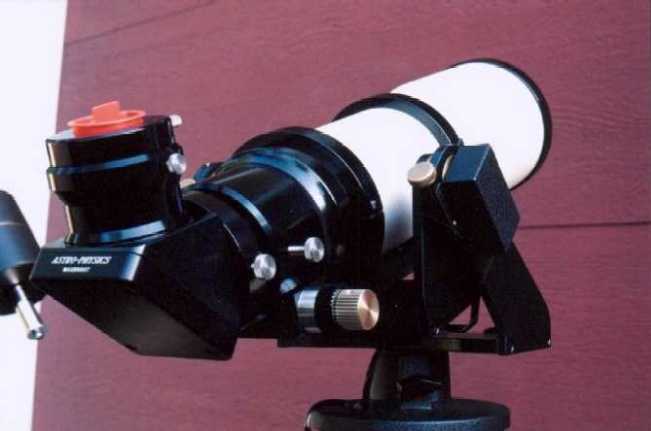 Detail of the right side of the scope.
The brass knob is the fine focus
We went observing on a couple of hot, humid July evenings, engaging in
an activity we New Englanders refer to as "feeding our pet mosquitoes."
The 6.5 lb OTA worked well on a TeleVue Gibraltar. However, there is
no provision for a finder. The star test showed virtually perfect optics
and no false color, remarkable for an f/5 refractor.
I spent some time hunting down the summer Messier objects, as well as
a number of galaxies in Ursa Major. The views are sharp and contrasty
and the images "snap" into focus impressively. What's more, the views
are crisp and sharp right out to the edge - again, an impressive achieve-
ment for a refractor operating a f/5. All four components of Epsilon Lyra
were easily split at 90X.
We had a great deal of fun with a 22 mm Panoptic (20X). You can see
Beta and Gamma Lyrae and the Ring Nebula all at once. M81 and M82
look like tiny whiskers or eyebrows within a vast sea of stars. With
an OIII filter, you can see all of the Veil, including Pickering's Wedge.
I wish that Jupiter and/or Saturn were up to test the scope's planetary
performance, but that will have to wait a few months. Watch this space.
However, keep in mind that deep sky performace is compromised
somewhat -- the Stowaway gives away 30% in light-gathering ability
vs the Traveler. However, it does have a larger aperture than the
Ranger/Pronto, the Takahashi FC76/FS78, and the TeleVue 85.
Detail of the right side of the scope.
The brass knob is the fine focus
We went observing on a couple of hot, humid July evenings, engaging in
an activity we New Englanders refer to as "feeding our pet mosquitoes."
The 6.5 lb OTA worked well on a TeleVue Gibraltar. However, there is
no provision for a finder. The star test showed virtually perfect optics
and no false color, remarkable for an f/5 refractor.
I spent some time hunting down the summer Messier objects, as well as
a number of galaxies in Ursa Major. The views are sharp and contrasty
and the images "snap" into focus impressively. What's more, the views
are crisp and sharp right out to the edge - again, an impressive achieve-
ment for a refractor operating a f/5. All four components of Epsilon Lyra
were easily split at 90X.
We had a great deal of fun with a 22 mm Panoptic (20X). You can see
Beta and Gamma Lyrae and the Ring Nebula all at once. M81 and M82
look like tiny whiskers or eyebrows within a vast sea of stars. With
an OIII filter, you can see all of the Veil, including Pickering's Wedge.
I wish that Jupiter and/or Saturn were up to test the scope's planetary
performance, but that will have to wait a few months. Watch this space.
However, keep in mind that deep sky performace is compromised
somewhat -- the Stowaway gives away 30% in light-gathering ability
vs the Traveler. However, it does have a larger aperture than the
Ranger/Pronto, the Takahashi FC76/FS78, and the TeleVue 85.
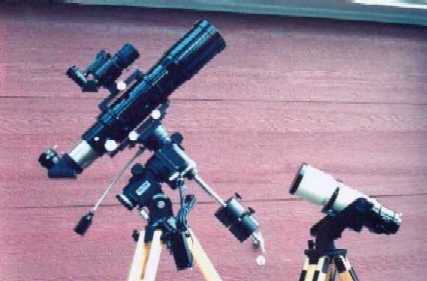 Tiny Astro-Physics Traveler, left, towers over
tinier Astro-Physics Stowaway, right
The AP90 would make a luxurious addition to larger telescope collections.
In a pinch, it can even serve as an all-purpose scope, although its small
aperture will hinder deep sky fanatics. The Stowaway will literally go
anywhere with you (around the world, if necessary) and the tiny case
will have no problems qualifying as carry-on luggage.
I hope you were lucky enough to get one of these.
End Telescope Reviews, Page 8
Tiny Astro-Physics Traveler, left, towers over
tinier Astro-Physics Stowaway, right
The AP90 would make a luxurious addition to larger telescope collections.
In a pinch, it can even serve as an all-purpose scope, although its small
aperture will hinder deep sky fanatics. The Stowaway will literally go
anywhere with you (around the world, if necessary) and the tiny case
will have no problems qualifying as carry-on luggage.
I hope you were lucky enough to get one of these.
End Telescope Reviews, Page 8
Back to Home Page
 Meade's Big Guns -- the 152 ED (left) and the 178ED (right)
Meade's Big Guns -- the 152 ED (left) and the 178ED (right) The LXD750 Mount
The LXD750 Mount Eeeny, Meeny, Miney, Dob...
The Orion 12.5" DSE, with the 10" and 6" Starfinders
Eeeny, Meeny, Miney, Dob...
The Orion 12.5" DSE, with the 10" and 6" Starfinders The Nikon APO aboard a G11
The Nikon APO aboard a G11 Nikon's attention to detail is apparent. Note the
controls on the finder and the graduated drawtube.
Nikon's attention to detail is apparent. Note the
controls on the finder and the graduated drawtube.
 Revenge of the Cute-Scope! The Stowaway
Revenge of the Cute-Scope! The Stowaway Detail of the right side of the scope.
The brass knob is the fine focus
Detail of the right side of the scope.
The brass knob is the fine focus Tiny Astro-Physics Traveler, left, towers over
tinier Astro-Physics Stowaway, right
Tiny Astro-Physics Traveler, left, towers over
tinier Astro-Physics Stowaway, right